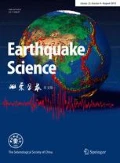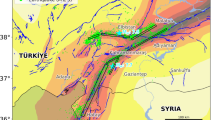Abstract
Based on the horizontal crustal strain derived from GPS data and the rate accumulation intensity calculated from across-fault vertical deformation, the strain characteristics in the periods of 1992–1995, 1995–1996 and 1996–1999 in Baotou-Datong area is studied in the paper. From the comparison between the crustal strains before and after the M=6.4 Baotou earthquake occurred on May 3, 1996, it is considered that the high-magnitude area with predominant compressive strain might be the seismogenic zone for a coming strong earthquake. The area with the simultaneous higher surface strain, principal compressive strain, shear strain and tendency accumulation might be the place with higher risk of strong earthquakes. Generally, the area with low strain and predominant tensile strain might have a small possibility for strong earthquake development, which belongs to a stable area. The evolution of horizontal strain obtained from GPS measurements carried out in Baotou-Datong area in the period of 1992–1999 reflects the total developing and ending processes of the seismic episode from 1996 to 1998. The area with high and predominant compressive strain and the strain gradient zone can be considered as one of the indicators for determining the strong earthquake risk area in the future.
Similar content being viewed by others
References
Billings M P ed. 1956. ZHANG Bing-xi trans. 1973. Structural Geology [M]. Beijing: Geological Publishing House, 29–31 (in Chinese).
Geological Dictionary Office, Ministry of Geology and Mineral Resources eds. 1983. Dictionary of Geology (Vol. 1) [M]. Beijing: Geological Publishing House, 20 (in Chinese).
GUO Liang-qian. 2000. Preliminary study on the horizontal crustal deformation in Chinese continent [J]. Earthquake Research in China, 14(4): 312–322.
HUANG Li-ren, MA Qing, ZHU Wen-yao, et al. 1996. Preliminary results of structural block movement model in the southwestern area of China obtained by high-precision GPS measurement [A]. In: LI Yan-xing ed-in-chief. Progress in GPS Technique Research [C]. Tianjin: Scientific and Technological Press of Tianjin, 232–229 (in Chinese).
LI Yan-xing, HU Xin-kang, ZHAO Cheng-kun, et al. 1998. Intraplate and plate-margin horizontal crustal deformation revealed by preliminary results observed at GPS tracing stations [J]. Crustal Deformation and Earthquake, 18(2): 28–34 (in Chinese).
LI Yan-xing, HUANG Cheng, HU Xin-kang, et al. 2001. Model of rigid and elastic-plastic motion in intraplate blocks and strain status of principal blocks in Chinese mainland [J]. Acta Seismologica Sinica, 14(6): 603–610.
LU Yuan-zhong, WU Yun, WANG Wei, et al. 2001. Dynamic Pattern Methods of Earthquake Prediction in Medium-Short Term [M]. Beijing: Seismological Press, 26–28 (in Chinese)
YU Hong-nian, LU Hua-fu eds. 1986. Principles in Structural Geology [M]. Beijing: Geological Publishing House, 96–99 (in Chinese).
Author information
Authors and Affiliations
Additional information
Foundation item: State Key Basic Research Development and Programming Project (G19998040700) and State Natural Science Foundation of China (40174029).
About this article
Cite this article
Guo, Lq., Bo, Wj., Hu, Xk. et al. Characteristics of crustal strain associated with M=6.4 Baotou earthquake in 1996. Acta Seimol. Sin. 15, 363–373 (2002). https://doi.org/10.1007/s11589-002-0029-7
Received:
Revised:
Accepted:
Issue Date:
DOI: https://doi.org/10.1007/s11589-002-0029-7




